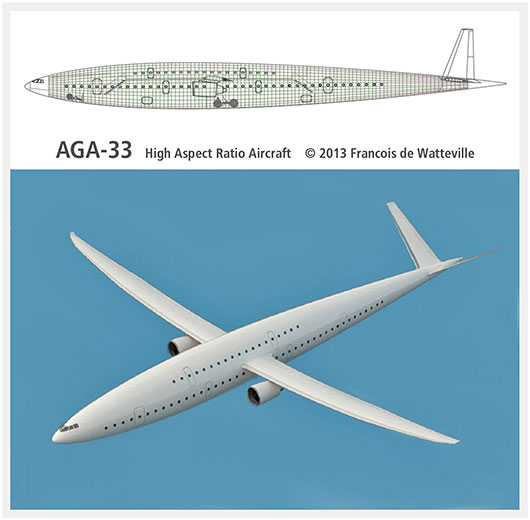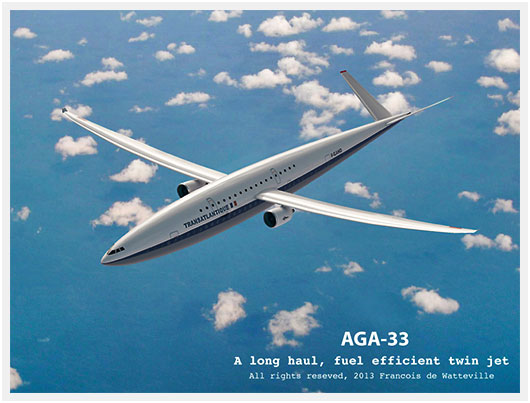AGA-33: High Aspect Ratio Airliner Concept From A French Industrial Designer
 Monday, June 3, 2013 at 11:51AM
Monday, June 3, 2013 at 11:51AM  Unique airliner concept from French industrial designer Francois de Watteville
Unique airliner concept from French industrial designer Francois de Watteville
click here to download an AGA-33 infographic
I'm a fan of airliner design... partly because I spent a lot of time as a kid riding on airliners and partly because I just like to see the best possible experience for everyone involved; from the owner/operator to the pilots to the passengers. So I was very interested when I received an email the other day from French industrial designer Francois de Watteville that included some advance info on an airliner concept he plans to present at the 2013 Paris Air Show coming up June 17-23.
I don't have a lot of details, but it appears his goal is to stir up debate about how to significantly improve the efficiency of moving people around by air. His design is named the AGA-33 and its primary feature is a very high aspect ratio wing. Additionally, his design works around the idea of making some significant design changes that allow the airframe to still do its job of hauling about 250 passengers while being smaller and thus lighter. A large reduction in weight in one area of the airframe can really translate into being able to save weight in other areas. It's like how the Avid Flyer appeared on the homebuilt aircraft scene back in the mid-eighties with an empty weight of about 360 pounds when we were used to 2-place airplanes weighing more like 500+ pounds. A focused effort on weight reduction (primarily thru re-thinking everything) can pay huge dividends in the end.
 AGA-33 airliner concept illustration... calculated L/D is 33 to 1
AGA-33 airliner concept illustration... calculated L/D is 33 to 1
Does Francois know what he's doing? I have no idea. But at the moment I'm not sure that even matters. Great ideas and revolutionary concepts often come from people who aren't involved in the daily practice of the specific discipline... and as a dreamer of these kinds of ideas myself, I see some real potential here. The big idea that I see is the more efficient use of the interior volume of the fuselage. By reducing the the ultimate ceiling height of the cabin, the AGA-33 allows for a second level of seating at the thick point in the fuselage while stretching the seating area out longitudinally to allow for more legroom. I just got back from vacation Saturday and we rode three different airliners each way to California and back (extra cheap tickets by going the long way) and I'll tell you that I would gladly trade some of the ceiling height for extra leg room.
I'm also a big believer in the idea of designing a slower airliner that needs a lot less fuel but offers greater comfort. It looks like the AGA-33 might be designed around this idea as well. I did a poll a few years back asking if you would slow down to 400 mph if the ride came with far greater comfort and more inflight activities to pass the time. Over 80% of the people in that poll said they would slow down. I know I would.
Anyway, it's always interesting to see future design concepts from people who aren't afraid to think different. It'll sure be interesting to see what kind of reception the AGA-33 concept gets from the 'experts' at the Paris Air Show. Stay tuned : )














































































Reader Comments (4)
I like the idea. I'm 6'4" and flying in an airliner is torture. I suspect that there are many who would trade speed for comfort. It's the part about trading dollars for comfort that most people have a hard time with, however. Our society seems to have given up good service and comfort for cheap and quick.
The fuselage on the AGA-33 reminds me of the Curtiss C-46. I like it!
A 2013+ Constlation
I can see a few design problems, not just with the aircraft, but with its integration into airports as well. The long wings wouldn't fit well in airports today and would have to fold at some point--a heavy and cumbersome feature. Also the control system would have to route through the middle floor, taking up a lot of space. Definitely not things that can't be overcome but they are some things to be aware of.
Well, he's allowed to dream, but ...
He should ask himself (or someone who knows) why all existing airliners have swept wings (and tails, for that matter.) Another characteristic to examine is the fineness ratio of the fuselage.
On the other hand, I can remember when 707's had decent seat pitch and you got a real meal with actual silverware and a cloth napkin on transcontinental flights (even in coach.)
Gad, I'm old.